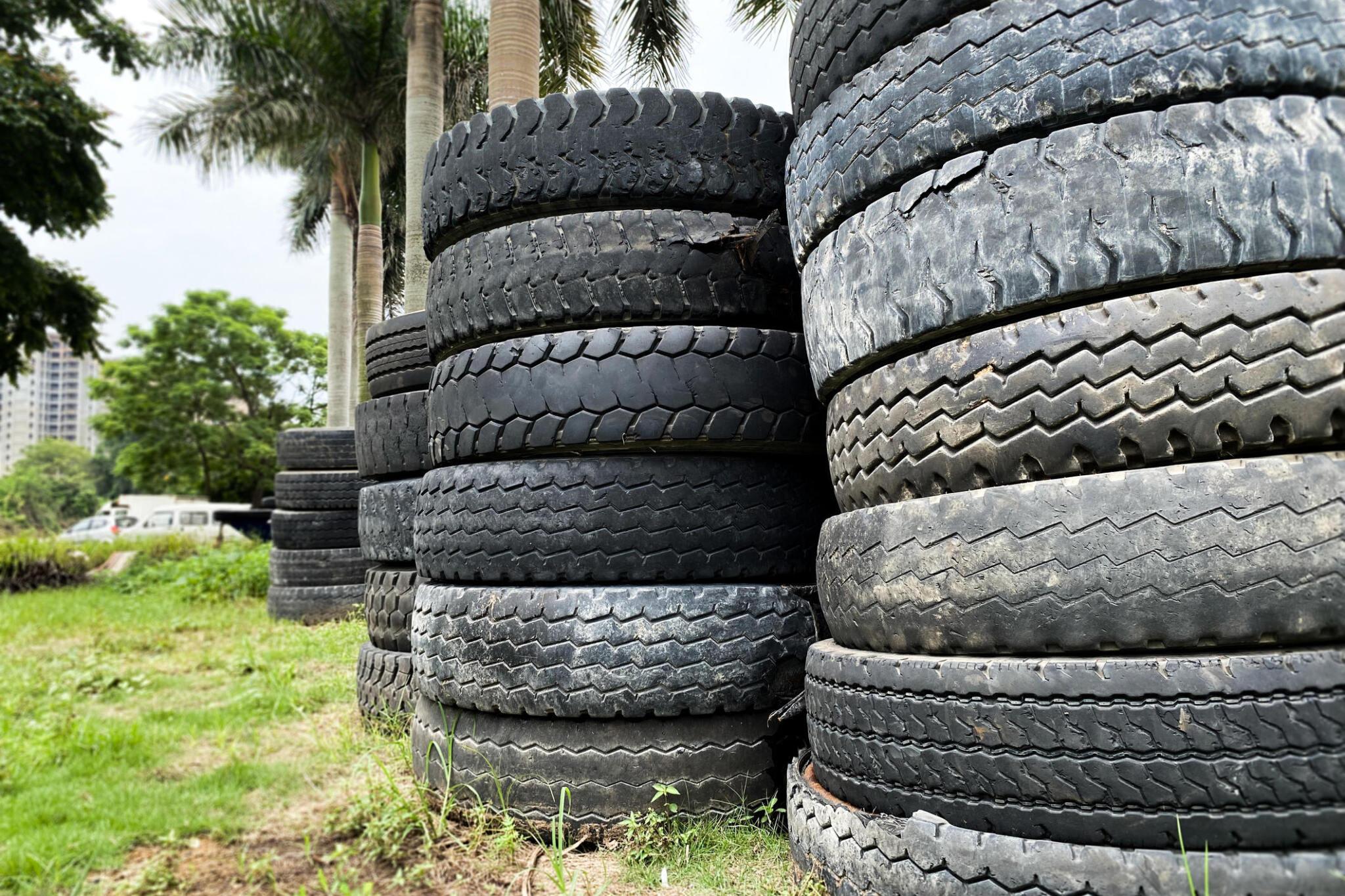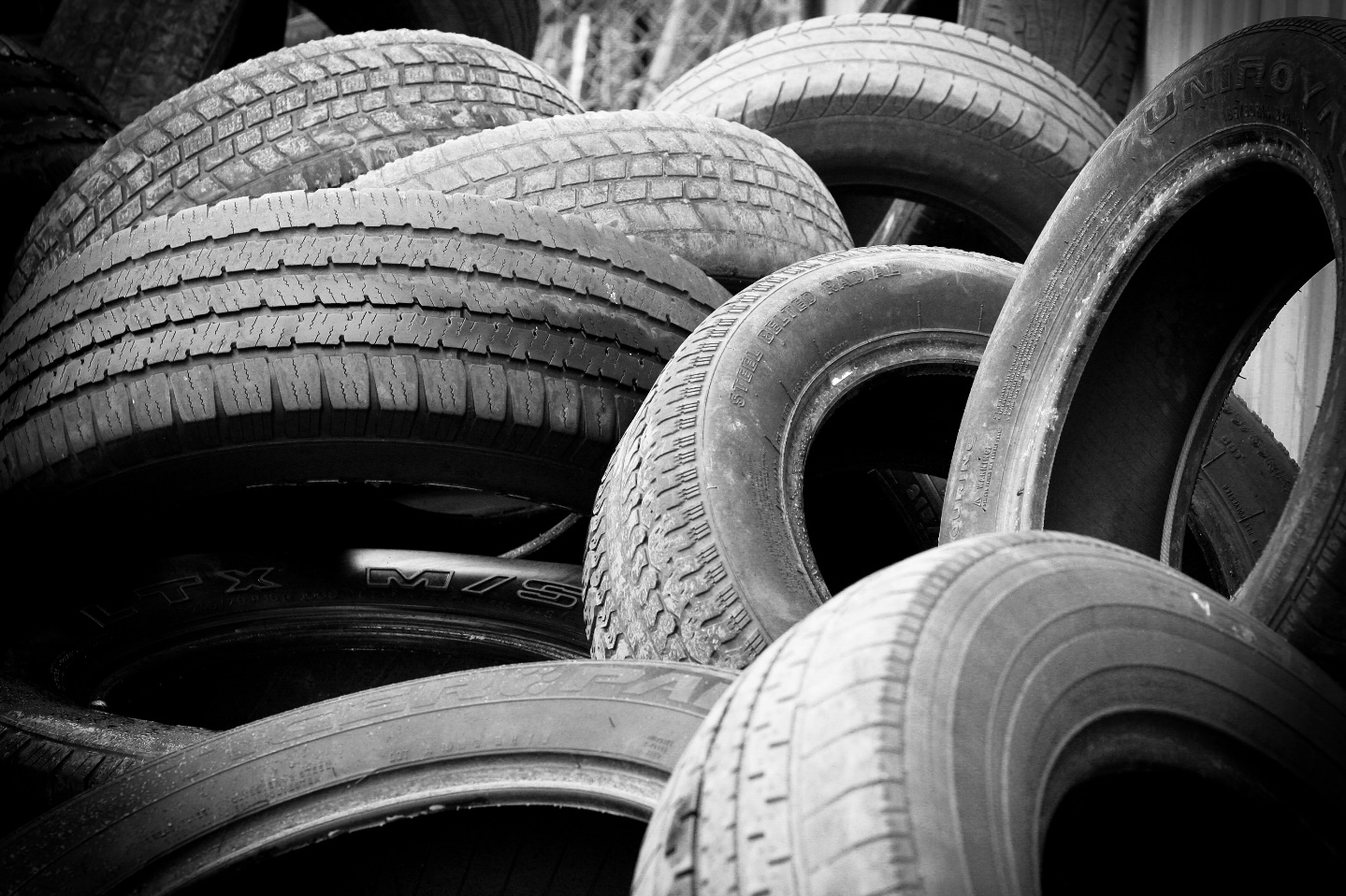Last Updated on January 16, 2025
Navigating the World of Old Tires Recycling
The tire is an essential component for vehicle safety, functionality, and efficiency. However, tires have a finite life, and disposing of old tires represents a significant environmental challenge globally. As we move forward, we must understand what happens to tires once they’ve served their purpose on vehicles.
This guide aims to shed light on the journey that tires undertake after they are no longer fit for the road, exploring both the lifecycle of a tire and the potential that lies in their responsible disposal and repurposing.
Purpose of the Guide
The primary purpose of this guide is to educate the reader on the various stages a tire goes through from the moment it is manufactured to the point where it must be discarded.
The guide seeks to answer several key questions:
- What exactly happens to old tires?
- How can they be disposed of responsibly?
- What are the environmental impacts of tire waste?
- Can old tires find new life in other forms?
These questions are essential, as improper tire disposal can lead to significant ecological damage.
Moreover, this guide is a knowledge resource for consumers, environmentalists, policy-makers, and businesses involved in tire production, sale, and recycling. By understanding the tire lifecycle and the importance of each phase, stakeholders can contribute to sustainable practices.
The guide also intends to highlight each stakeholder’s role and responsibilities in ensuring that end-of-life tires are managed in an environmentally sound manner.
Understanding Tire Lifecycle
The lifecycle of a tire is more complex than one might initially presume, involving various stages that extend far beyond its useful life on a vehicle. Here is a closer look at each stage:
- Manufacturing: It starts with tire production, where raw materials such as rubber, steel, and chemicals are processed and molded into our used tires. This phase has its environmental footprint in terms of resource extraction and manufacturing emissions.
- Distribution and Usage: Tires are distributed to retailers and eventually equipped on vehicles after manufacturing. The usage phase of a tire’s lifecycle is the most visible, as it involves the tire providing service to facilitate transportation. Proper maintenance can extend a tire’s life during this phase while driving habits can shorten it.
- Wear and Tear: Tires wear and tear over time, eventually reaching the end of their usable life. Road conditions, driving habits, and maintenance routines influence how quickly a tire wears out.
- Disposal: Once tires are no longer safe or legal, they must be disposed of. Unfortunately, many are thrown into landfills, stockpiled, or illegally dumped, which poses environmental and health hazards due to their non-biodegradable nature and potential to release toxic chemicals.
- Recycling and Repurposing: Fortunately, tires can be recycled and repurposed. They can be shredded and used in various applications such as asphalt modification, playground surfaces, or as fuel in specific industrial processes. Repurposing initiatives can transform tires into products such as footwear, mats, and even construction materials.
- Energy Recovery: Energy recovery can be an option for tires that are not recycled. Technologies like pyrolysis can extract valuable fuels from old tires, although these processes still need their environmental considerations.
Understanding each phase of a tire’s lifecycle highlights potential environmental impacts and opportunities for recycling and repurposing. This knowledge is foundational for developing and implementing sustainable practices and technologies that minimize tires’ ecological footprint from the cradle to the grave and beyond.

The Journey of Used Tires
The journey of a used tire, from its last rotation on a vehicle’s axle to its ultimate destination, is a narrative of contemporary waste management, recycling innovation, and environmental stewardship. We will explore phases of the used tire’s journey: its removal from a vehicle, the disposal process, and the associated ecological considerations.
From Vehicle to Disposal
A tire’s journey begins on the wheel of a vehicle, where it may travel tens of thousands of miles. Over time, the tread wears out, and the rubber degrades due to exposure to the elements, friction, and mechanical stress. When a tire’s tread depth reaches 2/32 of an inch, it is typically considered legally worn out in many jurisdictions. At this point, or sooner if it’s damaged, it must be replaced for safety reasons.
Once removed, the tire embarks on a new journey. The first stop is often the auto shop or dealership where the tire was replaced. Many of these establishments have evolved into collection points that aggregate used tires before passing them on to specialized recycling or disposal facilities. This is in response to various state and federal regulations that encourage or mandate the proper handling of tire waste.
In some regions, retailers charge a disposal fee for transporting and processing these tires. This fee supports a reverse supply chain, moving the tire from the last mile of use to the first mile of disposal or recycling.
The Disposal Process
The disposal process for used tires is a mix of regulated activities and innovative solutions to reduce the environmental impact of tire waste. There are several disposal routes, such as:
- Landfilling: Historically, used tires were thrown into landfills. However, many landfills now restrict whole tire disposal due to their bulky nature and propensity to trap methane gas, which creates potential risks for fires and pest habitats.
- Stockpiling: Some tires end up in stockpiles, which can be fire hazards and breeding grounds for mosquitoes and vermin. Thankfully, such inventories are becoming less common due to increased regulation and environmental awareness.
- Recycling: Recycling is the preferred option for tire disposal. Specialized facilities take in used tires and process them for various secondary uses. The recycling process often begins with a powerful shredder that breaks down the tire into smaller pieces. These pieces can then be further processed into crumb rubber or used whole for various engineering applications.
- Illegal Dumping: Despite regulations, some tires are disposed of improperly through unlawful dumping. This presents significant environmental and public health risks and is subject to enforcement actions and fines.
- Export: In some cases, tires are exported to other countries for reuse or disposal. This practice is controversial, as it often shifts the environmental burden to less developed regions.
Environmental Considerations
Below are some environmental considerations of tire disposal that are significant:
- Resource Waste: Tires contain valuable materials that can be recovered and reused. Discarding them in landfills represents a waste of resources.
- Pollution: Tires contain chemicals and metals that can leach into the soil and groundwater, causing pollution if disposed of improperly.
- Fire Hazard: Tire piles can catch fire due to lightning strikes, arson, or spontaneous combustion. These fires are difficult to extinguish and can release toxic smoke and runoff.
- Ecosystem Health: Illegal dumping of tires in natural habitats can disrupt local ecosystems and become an eyesore.
The journey of a used tire is filled with various environmental pitfalls. Still, with the increasing adoption of recycling and proper disposal practices, the narrative is shifting towards a more sustainable ending.
The key to improving this journey lies in innovation, regulation, and shared responsibility among all stakeholders to ensure that the final chapters of a tire’s life are written considering environmental integrity and human health.
Recycling and Repurposing
As environmental concerns continue to rise, the recycling and repurposing of used tires have become increasingly important. Thanks to innovative methods and applications, the tire’s journey from discarded waste has become a circular narrative of renewal and sustainability.
The Recycling Path
Recycling begins when a tire reaches the end of its usable life and is collected for processing. The recycling path involves several stages, each critical for transforming an old tire into a new, functional product. The stages include:
Shredding and Material Recovery
The initial step in tire recycling is shredding. Tires are fed into giant shredders that tear them into small pieces. This makes the tires more straightforward to handle and exposes the materials used in tire manufacturing for recovery.
The shredded tire pieces then pass through screens and magnets to separate the rubber from the metal and fabric components. The steel is extracted for scrap metal, while the remaining rubber, known as “crumb rubber,” is further processed or used as is for various purposes.
Applications of Recycled Tire Materials
Crumb rubber and other tire materials recovered during recycling have numerous applications. For instance:
- Construction materials: Crumb rubber is used in producing building materials such as rubber-modified asphalt and as an additive in construction projects for its sound-dampening and waterproofing properties.
- Automotive industry: Recycled tire rubber can be used to make new tires or automotive parts like floor mats, brake pedals, and seals.
- Sports surfaces: Athletic tracks, playground surfaces, and other sports flooring often incorporate recycled tire rubber for its durability and shock absorption qualities.
Repurposing Ideas
The creativity in repurposing tires is as boundless as the range of their original use.
In the Home and Garden
In the domestic sphere, old tires find new life in various forms:
- Planters: Cut and painted tires can become attractive and durable garden planters.
- Furniture: Tires can be transformed into tables, chairs, or ottomans with some creativity and the addition of rope or fabric.
- Playground equipment: Tires provide excellent, cost-effective swings or obstacle courses in children’s play areas.
Industrial and Commercial Uses
In more industrial contexts, repurposed tires serve functional and sometimes critical roles:
- Barrier reefs: Discarded tires are sometimes used to create artificial reefs, which offer habitats for marine life and reduce coastal erosion.
- Energy: Tires, due to their high heat content, are used as fuel in cement kilns and power plants. However, they can also be a valuable alternative energy source.
Tire-Derived Products
The versatility of tire-derived materials is highlighted in products designed for function and environmental benefit.
Rubber Mulch for Landscaping
Rubber mulch made from recycled tires is a popular landscaping material due to its resilience and longevity. It doesn’t decompose like wood mulch, providing a long-lasting, aesthetically pleasing, and low-maintenance option for gardens and public spaces.
Rubberized Asphalt for Roadways
Rubberized asphalt is a blend of asphalt concrete and tire crumb rubber. This mixture has been found to reduce road noise, provide a long-lasting roadway surface, and lower maintenance costs. Additionally, it can offer better resistance to cracking and rutting, especially in regions with extreme temperature variations.
Tire recycling and repurposing are examples of a circular economy in action. They not only divert tires from the waste stream, preventing environmental harm, but also add value by creating new products often superior to their non-recycled counterparts.
The innovation in tire recycling and repurposing also reflects a broader commitment to sustainable practices that can serve as a model for other waste streams.

Energy Recovery from Old Tires
As the search for sustainable energy sources intensifies, the energy recovery from old tires presents a compelling narrative of waste-to-energy transformation. Utilizing sophisticated technologies such as Tire-Derived Fuel (TDF), Pyrolysis, and Gasification, the energy content within tires is harnessed, offering an alternative energy solution with various benefits and challenges.
Tire-Derived Fuel (TDF)
Tire-derived fuel is one of the most common uses of shredded old tires. TDF is produced by shredding waste tires to make a high-energy-output fuel source. Tires have the same amount of energy as oil and 25% more power than coal when they are burned, according to the U.S. Environmental Protection Agency. Moreover, the ash content is less than coal, resulting in a lower emission rate of particulates.
TDF is used in various industrial facilities, including cement kilns, paper mills, and power plants. TDF can be burned alone or co-fired with other fuels, such as coal, offering a versatile and cost-effective energy solution. The high temperature of these combustion processes ensures the tires burn cleanly and efficiently.
Pyrolysis and Gasification
Pyrolysis and gasification are thermochemical processes that decompose organic material at high temperatures without oxygen (pyrolysis) or a limited oxygen environment (gasification).
- Pyrolysis involves heating tires in a reactor vessel without oxygen, which prevents combustion. Instead, the tires break down into three main products: solid (char), liquid (oil), and gas. The oil can be refined into fuels or used as a chemical feedstock, while the char can be used as a carbon black substitute or in char-create. The gas can be utilized for energy production on-site.
- Gasification transforms organic or fossil fuel-based carbonaceous materials into carbon monoxide, hydrogen, and carbon dioxide. This is achieved by reacting the material at high temperatures with a controlled amount of oxygen and steam. The resulting gas mixture, syngas, is a medium-Btu gas that can be used as a fuel to generate electricity or as an essential chemical building block for industrial purposes.
Benefits and Challenges of TDF
While TDF presents several benefits, it also presents challenges.
Benefits
Tire Derived Fuel (TDF) reduces waste by diverting tires from landfills and is a reliable energy source due to its high caloric content. Controlled combustion of TDF can also result in lower emissions than traditional fossil fuels. Below are more benefits of TDF:
- Waste Reduction: Using TDF and other energy recovery methods significantly reduces the volume of waste tires in landfills and dumps.
- Energy Recovery: Old tires are an abundant source of energy. The caloric content of tires is high, making them an efficient fuel source.
- Emission Control: When burned in a controlled environment with proper emission control technologies, TDF can produce lower emissions than conventional fossil fuels.
- Economic Advantages: TDF can provide a cost-effective alternative to traditional fuels, which can help lower industrial operational costs.
Challenges
Tire Derived Fuel (TDF) is a promising solution for tackling waste management issues and meeting energy demands. However, specific challenges need to be considered when adopting this approach, such as:
- Environmental Concerns: Burning tires, if not properly managed, can release harmful emissions, including NOx, SOx, and particulate matter.
- Technological Barriers: Facilities must have advanced burners and emissions control systems to use TDF, which can require significant investment.
- Market Fluctuations: The prices of traditional fossil fuels can influence the demand for alternative fuels, affecting the viability of TDF projects.
- Public Perception: There is often opposition to burning tires due to concerns over potential health and environmental impacts.
Utilizing TDF requires careful consideration of environmental impacts, investments in technology, and developing markets for the end products. With continued innovation and regulation, energy recovery from old tires can play a vital role in a sustainable energy future.
Environmental Impact
Tire disposal and processing have significant environmental implications, with direct and indirect effects on ecosystems, air and water quality, and public health. Addressing tires’ environmental impact throughout their lifecycle is essential for sustainable waste management and ecological preservation.
Impact of Tire Dumping
Tire dumping, the illegal disposal of waste tires in the environment, poses several environmental threats, such as:
- Fire Hazard: Tire dumps can catch fire, often burning for extended periods and releasing toxic smoke and pollutants. These fires are hard to extinguish and can contaminate air, soil, and water resources.
- Breeding Grounds for Pests: Tires can collect water and become breeding grounds for mosquitoes and other pests, which can spread diseases such as dengue fever, West Nile virus, and Zika virus.
- Habitat Destruction: Dumped tires can disrupt local habitats and landscapes, harming wildlife and plant ecosystems.
Emissions and Pollution
When tires are not disposed of or recycled correctly, they can significantly contribute to environmental pollution, including:
- Air Emissions: Burning tires releases harmful emissions, including volatile organic compounds (VOCs), particulate matter (PM), and other toxic chemicals like benzene and polycyclic aromatic hydrocarbons (PAHs), which can affect both environmental health and human respiratory systems.
- Leachate: As tires break down, they can leach harmful chemicals, including heavy metals such as lead and cadmium, into the soil and groundwater. These pollutants can accumulate in the environment and enter the food chain, posing risks to wildlife and human health.
- Carbon Footprint: The production and disposal of tires contribute to greenhouse gas emissions, which are implicated in climate change. This includes CO2 emissions from the manufacturing process and the release of methane from tires decomposing in landfills.
Mitigating Negative Environmental Effects
Mitigation strategies are essential to minimize the environmental impacts associated with tire waste, such as:
- Recycling Programs: Implementing comprehensive tire recycling programs helps to ensure tires are processed responsibly, diverting them from landfills and illegal dumping grounds.
- Energy Recovery: Using tires as an alternative energy source in controlled industrial processes can reduce reliance on fossil fuels and the environmental pollution associated with tire disposal.
- Innovative Uses: Encouraging the development of new products from recycled tires, such as rubberized asphalt or construction materials, provides an eco-friendly use for this waste.
- Regulations and Policies: Strengthening regulations around tire disposal, including the enforcement of anti-dumping laws and incentives for recycling, can significantly reduce the environmental footprint of tire waste.
- Public Education: Raising awareness about the environmental impact of tire waste and promoting responsible disposal and recycling can engage communities in sustainable practices.
By addressing each aspect of the tire’s environmental impact, societies can work towards a more sustainable and less polluting approach to tire manufacturing, usage, and disposal.

Legal and Regulatory Framework
Tire waste management is governed by a comprehensive set of legal and regulatory frameworks designed to minimize the environmental impact of used tires, promote recycling and recovery, and mitigate health hazards. These laws vary by country and region but share common goals in environmental protection and sustainable waste management.
Disposal and Recycling Laws
Most developed countries have stringent laws governing the disposal and recycling of tires. These laws typically prohibit the disposal of whole tires in landfills and require that tires be treated or processed before disposal to minimize their environmental impact. Here are the regulations in some countries:
- United States: The Environmental Protection Agency (EPA) does not directly regulate tire disposal. However, it encourages states to develop tire recycling programs. As a result, nearly all states have laws or regulations specifically directed at the management of used tires.
- European Union: The E.U. Landfill Directive and the End-of-Life Vehicles Directive play significant roles in tire disposal and recycling. These laws make it illegal to landfill whole and shredded tires and set forth guidelines for the responsible disposal and recycling of tires.
- Japan: Japan’s Automobile Recycling Law requires manufacturers and importers to recycle used tires and other parts. The law has successfully increased the recycling rate of tires.
International Practices and Standards
At the international level, practices and standards have been developed to guide tire waste management, including recycling and recovery. The Basel Convention, for instance, controls the transportation and disposal of hazardous waste, including dangerous tires.
- ISO Standards: The International Organization for Standardization has developed standards such as ISO 14001 for environmental management systems, which can be applied to tire recycling facilities to ensure environmentally sound management practices.
- Best Practices: Internationally recognized practices encourage the use of tire-derived materials in infrastructure, the development of markets for recycled tire products, and the application of extended producer responsibility (EPR) principles.
Compliance and Enforcement
Ensuring compliance with tire disposal and recycling laws is necessary for the success of any legal framework. Regulatory agencies are tasked with the enforcement of these laws through various mechanisms, such as:
- Audits and Inspections: Regular audits and inspections of tire storage facilities, processors, and disposal sites ensure compliance with environmental standards and regulations.
- Permits and Licensing: Regulatory agencies issue permits and licenses to tire recycling and disposal facilities, enforcing environmental protection standards.
- Penalties and Fines: Non-compliance with tire disposal and recycling laws can result in substantial fines, penalties, and, in some cases, criminal charges for responsible parties.
- Public Reporting and Transparency: Laws often require companies to report on their tire disposal and recycling practices, fostering transparency and allowing public oversight.
Compliance is not just following the law but also involves adopting industry best practices, investing in environmentally sound technologies, and engaging in corporate social responsibility. Companies leading the way in compliance set the standard for the industry and often go beyond legal requirements to ensure their operations contribute to sustainable development goals.
The legal and regulatory framework surrounding tire disposal and recycling is essential for managing the environmental impact of the millions of tires that reach the end of their useful life each year. Effective compliance and enforcement of these laws ensure that the tire industry operates sustainably and responsibly.
Innovations in Tire Recycling
Tire recycling is a field ripe with innovation. Ongoing advancements aim to improve efficiency and sustainability and create valuable end products. These innovations are essential in addressing the vast quantities of waste tires generated annually around the globe.
Advanced Technologies
Advanced technologies in tire recycling have revolutionized the way end-of-life tires are processed in the following ways:
- Cryogenic Grinding: This process involves freezing tires with liquid nitrogen, making them brittle and more accessible to crush into powder. The rubber obtained is used for various applications, including new tire manufacturing and athletic tracks.
- Hydrolysis and Devulcanization: Chemical and thermal processes break down the sulfur bonds in vulcanized rubber, returning the material to a pliable state that can be reformed into new products.
- Microwave Technology: Using microwaves in tire recycling is a new method that can devulcanize rubber without significant energy consumption.
- Pyrolysis: This technique decomposes organic tire material at high temperatures without oxygen, producing industrial oils, gases, and char, which can be used as a fuel or material in other manufacturing processes.
Case Studies of Innovation
Several case studies are provided below to highlight the potential of innovative tire recycling methods:
- Eco Green Equipment: Eco Green is a company that specializes in producing industrial-grade tire recycling equipment. Their innovations include high-efficiency shredders and granulators that maximize material recovery.
- Lehigh Technologies: Lehigh’s proprietary cryogenic turbo mill technology transforms rubber from end-of-life tires into micronized rubber powders that can be used in various applications, reducing waste and saving energy.
- Scandinavian Enviro Systems: Enviro’s patented technology recovers carbon black, oil, steel, and gas from waste tires using pyrolysis. Carbon black, a valuable material used in tire manufacturing, is recovered and can replace virgin carbon black, thus closing the loop.
Future Prospects
The future of tire recycling is shaped by the continuous development of innovative technologies, improved recycling methods, and new uses for recycled tire materials. Here are some prospects:
- Biotechnological Advancements: Research into using bioengineered bacteria and fungi to break down rubber is ongoing, and it has the potential to revolutionize how tires are recycled.
- Smart Tire Technologies: Integrating RFID tags and intelligent materials in tire manufacturing can make future tires more easily recyclable and their materials more recoverable.
- Regulatory Impacts: As governments worldwide continue to tighten environmental regulations, there is a push for industry-wide adoption of more sustainable and efficient tire recycling methods.
- Circular Economy Models: There’s an increasing trend towards developing closed-loop systems where tire materials are continuously recycled and reintegrated into new tire production, reducing the need for new raw materials and minimizing waste.
The tire recycling industry is currently experiencing a promising phase as technological advancements create new opportunities for sustainable practices and circular economies.
Tire recycling will likely become the standard practice rather than the exception. The focus is now on making these technologies scalable and affordable, ensuring that the benefits of tire recycling are maximized both economically and environmentally.
Consumer Role and Responsibility
Consumers are essential in the tire production, usage, and disposal cycle. Their choices and actions can significantly impact the effectiveness of tire recycling efforts and the sustainability of tire usage.
Choosing Recyclable Tires
Consumers can start making a difference at the point of purchase by opting for tires that are easier to recycle. Tire manufacturers are increasingly designing tires with the end of their life in mind, often using materials that recycling facilities can more efficiently process.
Factors to Consider
When choosing recyclable tires, focus on the material composition, favoring high natural rubber content. Check sustainability ratings for environmental impact, and support manufacturers committed to sustainable practices and tire take-back programs.
Material Composition: Look for tires with a high natural rubber content and less steel and fiber content, as they are often easier to recycle.
Sustainability Ratings: Some manufacturers provide ratings or labels indicating the environmental impact of their tires, including their recyclability.
Manufacturer Commitments: Support tire manufacturers actively participating in take-back programs or demonstrating a commitment to sustainable practices.
Participating in Recycling Programs
Once tires have reached the end of their usable life, consumers must dispose of them responsibly by leveraging tire recycling programs.
How to Participate
Here are good ways to participate in recycling programs:
- Local Drop-off Sites: Many municipalities offer recycling drop-off sites where old tires can be left for recycling.
- Retail Take-back: Some tire retailers offer take-back services, collecting old tires when new ones are purchased.
- Community Collection Events: Participate in community events to collect and properly dispose of tires.
Best Practices for Tire Maintenance to Extend Life
Extending the life of tires reduces the frequency with which they need to be disposed of or recycled. Proper tire maintenance is good for safety and performance and minimizes environmental impact.
Maintenance Tips
Here are good ways that you can extend your tire life:
- Regular Inspections: Frequently inspect tires for any signs of damage or wear and address issues promptly.
- Proper Inflation: Properly inflated tires ensure optimal performance and longevity. Under-inflated tires wear out faster and can even lead to increased fuel consumption.
- Rotation and Balancing: Regular tire rotation and balancing can even out tire wear and tear, significantly extending their life.
- Alignment Checks: Ensure that your vehicle’s alignment is checked regularly. Poor alignment can lead to uneven and premature tire wear.
- Driving Habits: Adopting smooth driving habits can reduce the rate of tire wear. Sudden starts, stops, and turns can contribute to quicker degradation of tires.
Consumers have a significant influence on tire lifecycles. By making informed purchasing decisions, participating in recycling programs, and practicing diligent tire maintenance, consumers can contribute to a more sustainable environment. Through these individual actions, the collective impact on tire recycling and resource conservation can be felt most significantly.
The Role of Manufacturers
Manufacturers have a critical role in the lifecycle of tires. From design to disposal, their practices significantly influence the environmental impact of tires. By emphasizing durability, recyclability, and sustainable practices, manufacturers can make the industry more environmentally conscious.
Designing for Durability and Recyclability
Prioritizing the design of durable and recyclable tires can reduce environmental impact and optimize resource use in the following ways:
Eco-Friendly Design: Manufacturers are increasingly adopting eco-design principles, focusing on creating tires that last longer and are easier to recycle. This involves:
- Using renewable materials that can be sourced sustainably.
- Designing tires that can be easily disassembled, allowing materials to be recovered and reused.
- Avoiding toxic materials that can cause problems during the recycling process.
Durability: Besides environmental benefits, designing for durability economically benefits consumers and manufacturers. Durable tires translate to fewer tire changes, less waste generated, and cost savings over time.
Innovation in Materials: Some manufacturers are exploring alternative materials, such as bio-based compounds or reclaimed materials, which can offer similar or better performance than traditional tire materials while being more sustainable.
Manufacturer Take-Back Programs
Many tire manufacturers have started implementing take-back programs to ensure responsible disposal of their products. These programs often involve:
- We are partnering with retailers to provide convenient drop-off points for consumers.
- They are working with recycling facilities to ensure that the materials from their tires are correctly processed and reused.
- Using the take-back programs to reclaim valuable materials like rubber, steel, and fiber for use in new tires or other products.
These initiatives not only help to mitigate the environmental impact of tire disposal but also contribute to the circular economy by bringing materials back into the production cycle.
Contributions to Sustainable Practices
Manufacturers play a significant role in the shift towards more sustainable tire use and disposal. Here are ways that manufacturers contribute to sustainable practices:
- Research and Development: Manufacturers invest in research and development to discover new recycling methods and innovate in sustainable tire production.
- Industry Collaboration: Some manufacturers are leading or participating in industry-wide collaborations that improve sustainability across the entire sector. These collaborations may focus on standardizing recycling processes or developing new technologies that companies can share.
- Education and Advocacy: Manufacturers can educate consumers about the importance of tire maintenance and proper disposal. By advocating for sustainable practices, they can raise awareness and drive change throughout the consumer base.
- Regulatory Compliance: Tire manufacturers are fundamentally responsible for complying with environmental regulations. Many manufacturers are going beyond compliance, setting internal standards that exceed the minimum legal requirements to demonstrate leadership in sustainability.
Case Studies
Case studies serve as valuable lessons for understanding how tire recycling can be implemented effectively and its potential for innovation and collaboration between different sectors. We will explore instances where tire recycling and utilization have shown notable success.
Successful Tire Recycling Programs
Effective tire recycling programs excel by offering accessible drop-off locations, working with local businesses and communities, and using new recycling techniques to turn tires into valuable products while minimizing their environmental impact.
Europe’s Leading Example
In several European countries, such as Germany and the Netherlands, tire recycling rates exceed 90%. This success is primarily attributed to legislation that holds manufacturers responsible for the end-of-life management of their products.
These programs are successful due to high public awareness, strict regulations, and effective take-back schemes, where manufacturers and retailers work together to collect and process tires responsibly.
Liberty Tire Recycling in the U.S.
Liberty Tire Recycling is one of the largest tire recyclers in North America, processing over 140 million tires annually. By recovering the rubber, steel, and fiber from these tires, Liberty Tire Recycling provides raw materials for new products.
The success of such companies shows that recycling tires can be profitable and has the potential to make a big difference in protecting the environment.
Innovative Uses of Old Tires Worldwide
Old tires are being creatively repurposed worldwide for various applications, such as building eco-friendly playgrounds, crafting durable construction materials, and even being transformed into fashion accessories. This shows how valuable and long-lasting recycled tires are.
The Genan Business Model
Genan is a Denmark-based company that operates the world’s largest tire-recycling plant. They have innovated in the field by turning old tires into new raw materials such as rubber powder, granulate, and steel.
Their products are used for various applications, including artificial turf fields and playgrounds, and as an asphalt additive for road construction.
Artistic Endeavors in South America:
In countries like Brazil, old tires have been transformed into creative and artistic installations in public spaces. This recycles the material, promotes culture, and provides a unique aesthetic to urban environments.
Aquatic Habitats:
Discarded tires have been used to create artificial reefs in oceans worldwide. These reefs provide habitats for marine life, contribute to marine ecosystems, and promote biodiversity.
Public and Private Sector Collaboration
Collaboration between the public and private sectors is necessary to enhance tire recycling efforts, involve shared initiatives for sustainable waste management, fund innovative recycling technologies, and establish policies that encourage the responsible disposal and recycling of tires.
The Bridgestone-Ford Partnership:
Bridgestone Americas and Ford Motor Company partnered to establish a tire collection program to ensure the responsible disposal of used tires from Ford’s company-owned vehicles.
The collaboration is an excellent example of how the public and private sectors can work together to solve the challenge of tire disposal.
EcoPark in Taiwan
The Taiwan government developed the EcoPark, a dedicated industrial zone for recycling and waste management companies, in collaboration with private companies.
Such public-private partnerships provide the infrastructure and policy support necessary for companies to invest in recycling technologies and develop new uses for recycled tire materials.
These case studies demonstrate that successful tire recycling requires innovative technology, processes, and collaborative efforts spanning various sectors.
Success stories worldwide offer inspiration and a blueprint that can be customized to fit local circumstances. They have led to better tire recycling rates and promoted innovative applications for recycled tire materials. They exemplify the positive impact of synergy between regulatory frameworks, commercial incentives, and creative thinking in addressing the challenges of tire waste.
Conclusion
Every stakeholder in the tire lifecycle plays a significant role in creating a sustainable future. Manufacturers must continue to innovate and design tires with longevity and recyclability in mind.
Consumers should be proactive in their tire maintenance and disposal practices. By committing to the environment and sustainable practices together, we can reduce the ecological footprint of our tire usage.
To this end, we urge all readers to consider their role in tire lifecycle and take actionable steps. Whether opting for recyclable tire options, participating in local recycling programs, or advocating for better tire waste management in your community, every action counts.
Why Tire-Easy
Understanding the importance of sustainability in tire usage does not end with disposal—it begins at the moment of purchase. Selecting the right tire can improve your vehicle’s efficiency, extend the life of your tires, and eventually contribute to the recycling stream effectively. That’s where Tire-Easy comes in.
At Tire-Easy, we are committed to offering you a diverse selection of high-quality tires that promise durability, performance, and compliance with environmental standards. Our user-friendly platform ensures you can find the perfect fit for your vehicle, contributing to your eco-friendly driving practices from the get-go.
So, as you make responsible choices for a greener planet, let us be your partner in the journey. Please browse our extensive range of tires, make an informed purchase, and drive confidently, knowing you’re doing your part for the environment.
Find Your Perfect Tire Today
Choose wisely, drive safely, and recycle responsibly with Tire-Easy.
FAQs
What do tire shops do with old tires?
Tire shops typically collect old tires and send them to recycling centers or facilities specialized in repurposing or converting them into tire-derived fuels. Some are also shredded for use in construction materials or playground surfaces.
Do old tires decompose?
Old tires do not decompose quickly. Made from durable rubber compounds that withstand harsh conditions, they can take over 50 years to decompose in a landfill, making recycling and repurposing essential.
What can be done with old tires?
Old tires can be repurposed into various products, such as rubber mulch for landscaping, mats, and playground surfaces. They can also be recycled into materials like rubberized asphalt or used as fuel in some industrial processes.
Where do worn tires go?
Worn tires are often collected by recycling programs and taken to facilities where they can be processed for various uses, including creating tire-derived fuel, construction materials, or rubberized products for consumer or industrial use.
Are old tires good for anything?
Yes, old tires can be beneficial. They’re often recycled into construction materials, floor mats, and artificial reefs. Alternatively, they can be creatively repurposed for DIY projects like garden planters or outdoor furniture.
What happens to old tires?
Old tires are collected, recycled, repurposed, or used for energy recovery. Recycling involves breaking them down into rubber crumbs, while repurposing can involve creative uses, and energy recovery typically involves using them as fuel in industrial processes.
How old tires are OK?
Tires older than 5 to 6 should be inspected regularly, even if used sparingly. Typically, tires should be replaced after ten years regardless of their visual condition, as the rubber compounds begin to degrade with time and can compromise safety.
-
Writer










 English
English Français
Français Español
Español